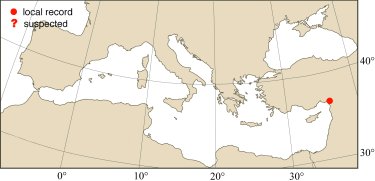|
Relevant Synonyms
Misidentification
|
||
|
SHORT
DESCRIPTION
color :
light olive-greyish, darker rostral crest.
common size :
maximum total length 20 cm males, 24 cm females. |
DISTINGUISHING CHARACTERISTICS
BIOLOGY / ECOLOGY
habitat : |
|
1st
MEDITERRANEAN RECORD
|

|
|
DISTRIBUTION
|
ESTABLISHMENT SUCCESS
speculated reasons for success :
|
|
|
MODE OF
INTRODUCTION |
IMPORTANCE TO
HUMANS |
|
KEY
REFERENCES
|
|
|